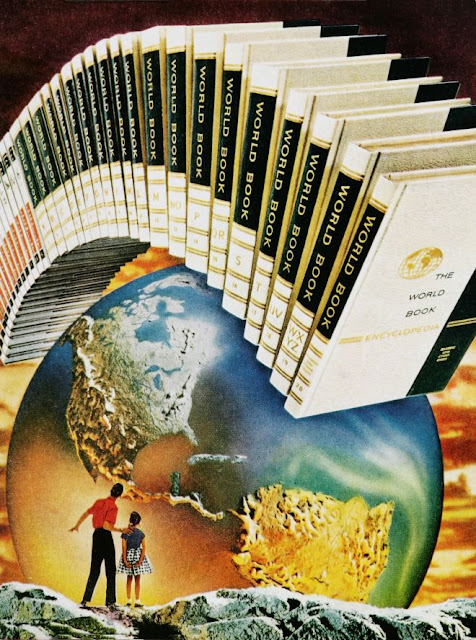Encyclopedia sets were a sign of mid-century prosperity. Your family could own the SUM KNOWLEGE OF THE WORLD. It wasn't called the World Book for nothing.
Much of the advertising of the time posited the encyclopedia set as a preparatory tool for the future. Typewriter advertisements of the same period and flavor made the argument that a new typewriter would ensure success for your children. That success was, of course, purely financial because at $1600 (adjusted for inflation) the encyclopedia wasn't cheap.
Open to a page and you could find an article about pretty much anything. To a kid in northwest Indiana, it was really a world book; the sum of all knowledge. I loved to look at the title page for each volume because there was a little area that showed the progression of the letter from the Egyptian hieroglyph, the Greek letter, and to the Roman alphabet. Information covered every page. The special pages were my favorite; fold out maps, color plates of "Costumes of the World", and the layer-by-layer visible man printed on acetate sheets .
Today, the internet is my World Book and I was trying to do a deep dive on these things:
If you think they look like old-timey ceramic insulators in cobalt blue, you would be correct. They are old-timey insulators in cobalt blue. These kind of bee-hive insulators were common with electric hobbyist in the first half of the 20th century. If I was to look up insulators in the old World Book there wouldn't be an entry for them. There might be a reference to insulators in the entry for electricity, but the granularity of the internet is its best quality. If you look hard enough you will find something that will point you in the right direction.
A few minutes of my time revealed a number of sites dedicated to people who love antique electric insulators:
As fans of typewriters, I think we are well past the point of shock at discovering that the internet is filled with wonderfully esoteric digital communities supporting unusual hobbies. Deep in the archives of NIA, there are digital copies of "Old Familiar Strains", a newsletter for collectors of antenna insulators and related items. The October 1997 edition of the newsletter covers Birnbach ceramic isolators and there is even some clip art namely:
However, the insulators that I have are blue, not white or brown. Still, they are the same kind. The World Book internet helped me find out more about these little ceramic doodads. What am I going to do with them? I am glad that you asked.
Let me take you to a more electrifying time: 1929! That year was a sea change for amateur radio (also called ham radio of which I am a practitioner under the callsign KC7RZR). Two years earlier, in 1927, the Radiotelegraph Act set up a federal radio commission. In the winter of that same year, 72 countries gathered in Washington DC for the International Radiotelegraph Conference and hammered out an agreement that would finally regulate the radio spectrum. Ham radio operators would have to clean up their act and leave behind the unregulated world of early radio and embrace 1929-style radio.
QST, a hobbyist magazine of the ARRL, covered the deadline frequently and offered plans for 1929 compliant transmitters. So many of these builds were breadboard (as in make from a breadboard) because commercial amateur radio equipment is a oxymoron. These early hams were supposed to build a transmitter and that is what I am doing.
In my quest to build a TNT transmitter, I've started collecting the parts. I have quite a few to go, but I thought I would share this unusual item and hobby.
How common are these be-hive insulators? Not common enough for the antique radio enthusiast. There are no new manufacturers, but I have a trick up my sleeve and it includes my love of hobbyist ceramics...






